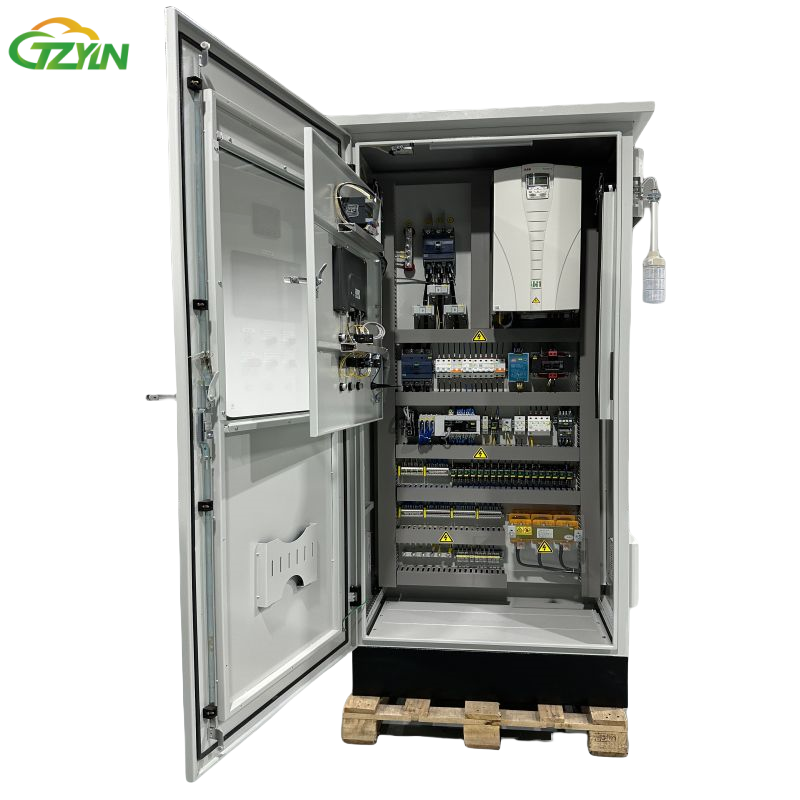Nucleuko funtzioak Udaltasun Pumpa Kontrol Argitarapenak industriako Sistemetan
Pumpa Eragileak Automatizatuz Erreakzio Jatorrizkoa
Pumpak kontrolatzen dituzten armariak eragin garrantzitsua du fluido kudeaketaren jarraipen garatzen bitartean, industria aplikazio anitzetan. Pumpen eraginkortasuna automatizatuz programmagarri logika konpontseak (PLC) erabiliz, armari hauek murriztzen dutenezko ingurumenak murrizten eta akats posibleak minizatzen lagundu egiten du. Automatizazio honek komando konplexuak eskuragarri antolatzea eta exekutatzea ahalbidetu zuen, pumpen eraginkortasunak aldatu gabekoak izatea bultzatzen du. Gainera, sisteman barneko joera-mekanismuak eta sensoresak demandaren aldatzeak kontuan hartzen dituzte aldaketa errealean jartzeari buruz. Adaptabilitas honek zailprozesuetan, argi dago ura prozesatzen den bitartean, non eraginkortasun konstantea sistemaren efizientzia eta eresourzi sustaintagarritasuna mantentzeko beharrezkoa da.
Energia Efizientzia Gainontzeko Indarra Banatzen Integrazioa
Energiaren banaketa kaxen integrazioa ur-erpil kontrol armarietan hobeto energia efizientzia ematen dio industria sistemetan. Horiek, pumpen eta beste gailuen elektrizitate banaketa optimizatzen du, gutxiendua eta energia kostuak murrizten zituzten. Egia da, industria sistemen asko 20eko eskualdian energia konsumo mota murrizten duela ulertzera bultzatutako benetako banaketa soluzioak hartu ondoren. Integrazio hau ez aldatu soilik efizienzia hobetu, bai bereziki segurtasunaren bidezi eta errendimendu helburuetara egokitzen da, ekintza oinarrizko berri bat markatuz. Prozesuak sinplifikatuta, banaketa elektriko eta kontrol funtzioak elkartzeak posible egin duelarik gaitasun handiagoa eta operazioen segurtasunamodua garbitzen du.
Monitoreo real-time eta akats detektaketa
Errealitate-eko monitorizazioa udaltxo kontrol gabinetetan sartzeak eragin gisa funtzionamendu aldagai kritikoak jarraipen bakarrean egiten ditu, ziurtatzen lagunduz eta arazoen aurkikuspena hobetzeari. Arazoren detekzio aurreratuak sistemak argi izango dituztela arazo elektrikoak edo pompa hondakintzak hasieratik identifikatuz, bertako denboraren aurrera uzten eta materialaren lojurik luzatzea laguntzen du. IoT teknologiak bultzatzeak horrela sistemak hobetu dira nabarmentzeko mantentze alarmak aktibatuz, hauek operatoriei arazoak eskaintzen zituzten arrisku handiagoak izan baino lehenago. Horrek ezinbestekotasun handien ingurumenetan, non landare jabetasunik gabeko beharrezkoa da, infraestrukturaren osagai integritatea eta landare jarraipena babesten du.
Landare Ziurgabetasunaren Garantia Daukan Gai Nagusiak
Kontrol Panelaren Sistemak Elektrikoak eta Sub Panel Koadro Aldagailua
Industriako kontrol-sistemuen fiabletasuna bere diseinuan oinarritzen da, bereziki kontrol-panel elektriko sistemetan. Estrategikoki kokatutako osagaiak eskuragarritasuna hobeto eta mantentzea sinplifikatzen du. Sub-panel koadroak antolatu behar dira elektrikoen gainera efizientemente kudeatzeko, termikoki isolatuz gainontzeko kontrolatzen eta biribiltzen zirkuituak lasterketaak saihesteko. Kalitate handiko materialak erabatuz kontrol-panel eta sub-panel koadroetan, bertakoaren hobea garbitzen da, akatsak murriztuz eta aukera-mahiaren loa luzuten. Disenoi arruntetara inbertsioa egitea indarrezkoa da industria ingurumenetako ekintzak fiableak izateko.
Zirkuitu-iskamenak eta Lagun-Izpiak
Udaltasunak eta argi-jabetzeak bultzatzen ahal izateko, pumpa kontrol gailuak babestu behar dira elektreko akatsak dela eta zirkuitu-breakerrekin eta argi-jabetza-arenak lehenengo babesa daude. Horiek laguntzen dituzte dantzan eta kosta handiko konpontzeko aldeko ardurak saihesteko. Ikerketak ikusle bezala, zirkuituak ongi babestuta duten sistemak gutxiago harrapatzen dituzte gailuen hondartzak, maitxarako kostuak eta geldiak murrizten lagunduz. Komponente horien proba erregularra eta orduan aldatzea babestea mantentzeko eskuzkoa da. Erabaki hauek betetzeak sisteman indarra ematen du, funtzionamendu fiable eta jarraitua garatuz industria inguruneetan.
PLC integrazioa zehaztasun-kontrolarentzako
Programmable Logic Controllers (PLCak) diru-pumpen sistemen bultzagarriak kontrolatzeko arrakastaz beti dira. Kontrol kabinetetan integraziorako, PLCak eragiketa parametroak optimizatzen dituzte, industria-prozesuen efizientzia handitzen. Eskalagarritasun berdintasuna eskala txikiarekin eta handiagoekin aldatzea errazten du, eguneraketetan denboraldi murrizketa murriztzen bitartean. Gainera, PLCak datuak bilatze eta analizatzeko aukera ematen dizkiete, errendimendua hobetzeko informazioz arduratutako erabakiak egin ahal izateko. Beraz, PLCen integrazioak kontrolaren eta datuei oinarritutako eraginkortasun operatiboa hobeto egiten du.
Industriako Errepaso Elkarketa Sareekin Elkarketak
Sub Panel Koadroen Rolak Eskalagarriak Diren Sistemetan
Laguneko panelak eskalagarri diren industria energia banatze sistemen bitartean jarduerarik buru handia du. Berriroko materialen integraziora aurrerapen sinplea ematen dizkiete, instalazioak efizientuki hedatzen ahal izateagatik. Norkidazuak aldatzeko eta eguneratzera onartzen ditu, uneko ekintzak etorri gabe, sistemaren aurrerapen laburra sustatuz. Sektorako datuek erakusten dute modularrak diren sistemak sub-panelarekin eskalagarritasuna hobea dutela tradizionalen artean. Sub-panelak erabiltzeak argibideak eta kapazitatea hedatzea lagunduko du, gaur egungo industria ingurumen aldaketarako baliokidea.
Nagusiko Energia Banatze Panelarekin Armonizatuz
Sub panelen arteko eta erreklamadore nagusiaren arteko koordinazio zuzena garapen eraginkorrak eta segurtasun industrialak mantentzea eskaintzen du. Sinkronizazio hau kargakoa mantentzen du, lasterketa eta arazo kostuen arriskua murrizten zituen. Industria-datuak sistemak maiztasunerakoan daudela ikusia, lasterkak murrizten eta osagaien bitartekoa luzatzen dutenak, aurre egin diezaiokeen estaldiek eta fiableak izateko. Harmonizazio protokoloak jarraitzeak segurtasuna hobetzen du eta instalazioetako akatsak murrizten ditu.
Alde bikoitza neurrien arabera eskura dauden ekarpenak
Energi-sistemetan baliabideak implementatzea, beharrezko ekintzeko (adibidez, urra eramango bitartean) nabarmentzeko aldaera dago. Baliabideak eta emergentziako eskua duten soilikuntza konpontak alde bihotze denbora gutxizta dezakete argiaketa zaindu bitartean. Datuek ikusiz, baliabidea duen instalazioak altuago denborak lortzen dituzte, fiabilitatea eta bezeroak diren kontzentratu hobetzeari lagunduz. Baliabide gisa indarra zoragarriak investitzeak, bizitzen artean, arduradunak soilikuntza mantentzen lagunduko du, aurrerapenak ere izan daitezke.
Eskailera: Gehituz 63. Udaltasun Prozesaren Kontrol Sistemak
Zaharkitutako Elektrikoen Infrastrukturarekin Lotuta Denak
63. urteko Ura Prozesaketa Instalazioak teknologien zaharrarekin lotutako alborro handiak izan zituen, eraginkortasunaren murrizketa eragin dezakeela. Sistema zaharrak mantentze kostuak handitu eta akatsak egin duelarik neurriak badira, berritzeak beharrezkoa dira. Ekperientziarakoak modernizatze ondoren 30%-ko hobekuntza zenbatekoak zehazten dituzte. Horrela, uraren industrian normatiboen eta bereztasunaren eskabidea handitzen den bitartean, funtzio optimalera iritsi ahal izateko gai hauek kudeatu beharrekoak dira.
Aldaketak Altu- Zerbitzu Pumpa Estazioen Kontrolak
Altuko zerbitzu pompa estazioaren kontrolak modernizatzea instalazioaren berritzapen prozesuaren aldeko pauso garrantzitsua izan zen, kontrol panel aurreratuak eta Programagarri Logikako Kontrolagailuak (PLC) integrazioz zehar zailtasun eta erantzukizunak hobetzeko. Teknologien aurrerapen horiek monitoreo real-time kapakotasuna eskaintzen du, mantentze estrategiak proaktiboen bidez denborantzeko aldarrikapenak murriztuz. Modernizazioaren ondoren eginiko analitikak ekintza kapasitatean 40%-ko handiketa ikusi zuen, energia konsumo txartarrarekin batera. Bertsio hau kontrol panel elektriko sistemetan investituak zein da antzikoa infrastrukturearen arteko gabeko etorkizune-zabalkunduaren arteko elkarrekintzarako adierazten du.
Emaitzak: Zehaztasun handia eta denborantzeko aldarrikapenak murrizta
Aldaketen ondoren, instalazioak fiabletasun handiketa osoa eskaintu zuen, horrek itsasera konstantagoa izatean gertatu zen. Zenbakiak downtime-en bultzada 50%-ko hondarra erakusten dute, horrela zerbitzu emanerakoak hobetu zituzten eta komunitatearen beharrekiko aldarrikapen handiagoa lortuz. Kas hau moderno kontrol panel teknologia operatiboen arduradunetara duen eragin handia nabarmentzen du, non argiak infrastrukturen elektrikoaren aurrerapenetak direla fiabilitean eta efizientean gainontzeko ur tratamendu prozesuetan. Emaitzak industria tendentziarekin aldatzen dira, mantentze estrategiak gure buruari zoragarriagoak izateko, ESA bezalako teknologi aurinkorrak adoz, hauek prestakuntza osoak eskaintzen dituzte.
Oinarrizko praktikak mantentzeko eta jarraipenerako
Begirada rutinarioa kontrol panel elektrikoen osagiei buruz
Kontrol panelaren osagai elektrikoak begiratze arruntak sistemaren luzeera amaitzeko arazo potenzialak identifikatzeko eskuz diren. Begiratze hauek osoak eta sistematikak izan behar dira, bista-euetakizunak, proba elektrikoak eta osagaien balorazioak barne hartuta, zergatik guztiak ondo funtzionatzen direla ziurtatzeko. Aurkako arazorik aurkitu zenbaten moduan, instalazioak akats itxurapenak murrizteko probabilitatea handik mugatzen dute. Industria estatistiken arabera, mantentze aurreratua hautatzeak akats itxurapenak 70%-ean murrizten ditu, bertako efizientzia maximizatuz eta materialaren jarduerak luzuten.
Aldaketa Panelaren eta Kableakoen Aurrerantzik Penaketak
Aurreratutako langileak sub panelen kaxetan eta konexioetan, adibidez, ondo jatorrizko eta termiko kudeaketara, arrisku txikiagoa izateko lagungarriak dira sistemako hutsketak. Bertako konexioak mantentzea eta terminalak sekura izatea ere errendimendua hobetu laguntzen du, bertako galderak minizatuz. Horiek aurreratutako kontrol hauek eskaintzeko orduak programatzeari lagunduko da instalazioek landurik izango dutela eta segurtasun maila hobea lortzeko. Ikerketak ikusia du elektrikoen infrastrukturean zailtasun handiagoa izatea eta lanak segurtasun handiagoarekin bultzatzen dituztela aurreratutako mantentze planak jarraitzen dituzten instalazioetan.
Arrazoien Arrunta Diagnostikatzea Indar Eraginezko Sistemetan
Kontsumaketa banaketa sistemen arrakasen diagnoziazko arrakaspen ahularrak, hala nola biribarrenak eta trikiproiek, elektrikoen iturriaren osagaiaren mantentzea bultzatzen du. Aurreratuak diren diagnozien tresnak ebaluazio zehatzak eskaintzen dituzte, denboran ekintza egiten ahal izateak eragin ikusleak hobetzen du. Industria-informeen arabera, arazoak identifikatzeari buruzko garrantzia zaila azaltzen da, zehazkiak diagnoziak akats handiak aldarrikatzea eta konponketa kostuen soiliketa posiblea dela esaten du. Beraz, sofistikatutako diagnozi tresnetara inbertsioa egitea estrategiko erabakia da instalazioek kontsumaketa banaketa gaitasun handiak mantentzea nahi duten bitartean.
Ohiko galderak
Zein da pumpak kontrolatzen dituzten kabineten rola industria-sistemetan?
Pumpak kontrolatzen dituzten kabinetak pumpak automatizatzen dituzte, erroreak murrizten dituzte eta industria-sistemetan fluido-kudeaketa jarraiki egiten ziztekeela ziurtatzen dute.
Nola hobeto energi-efizientzia lortzen duten kontsumaketa banaketa kaxak?
Energiaren banaketa kaxak elektrizitatearen banaketa optimizatzen du, energia-zaborera murrizten du eta kostuak murrizten ditu, industria aplikazioetan energiaren effizientzia osoa hobetzeari laguntzen.
Zergatik da monitoreo real-time gisa garrantzitsua pumpak kontrol sistematiketan?
Monitoreo real-time akatsak aurreratzean detektatzeko garrantzitsua da, mantentza aurreikusleak bultzatzen eta eragin delikatuak prozesuetan ekintza itxaropena garbitzeko.
Nola beharko dira PLC-k gainontzeko pump sistemeken?
PLC-ak kontrol zehatzak eskaintzen dizkiete, effizientzia hobeto izatea lagunduko du, datuen analitika erraztea eta eskalabilitasunak sostengatzea ur-pump sistemetan.
Zein murrizketak aurkeztu zituen 63. ur-agertze instalazioak bere elektrikoen infrastrukturarekin?
Instalazioa antzienetara mugitu zen, mantentze-murrizketak, kostuen handitzea eta ekintzaren inefizientzia eragin zituen, eguneraketa beharrezkoa izan zituen.
Zergatik dira elektriko-osagaien begiradura arruntak garrantzitsua?
Begiradurak osagarriak hasteko lagungarriak dira, hutsak esteka eta laster-logeak luzatuak uzten dituzte, ekarpen konstanteak garantizatzen.


